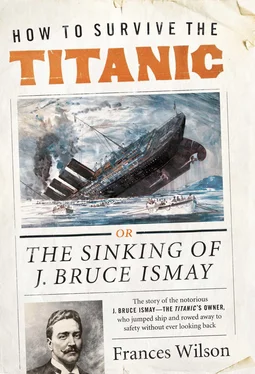The force of Ismay Senior’s personality eclipsed that of his partner, William Imrie, a quiet, modest and cultured man known as ‘the prince of shipowners’. Thomas Ismay became famous in the shipping industry for having never offended a rival, for creating thousands of jobs in Belfast, for offering the use of his entire fleet to Queen Victoria for service during the Boer War, for founding a training ship, the Indefatigable, which began the shipping careers of over 2,000 boys from poor homes, and for starting a pension fund for Liverpool sailors. He was chairman of the Board of Trade Life-Saving Appliances Committee, Justice of the Peace for Lancashire and Cheshire, a member of Lord Hartington’s Commission on the organisation of the Army and Navy and of the Royal Commission on Labour, and he was Deputy Lord Lieutenant and High Sheriff of Cheshire. He turned down as many positions and titles as he accumulated, whether the chairmanship of the London and North-Western Railway Company, the suggestion that he stand for Parliament (he was a Liberal Unionist) or, in 1897, the offer of a baronetcy. In a letter to Bruce, Thomas compared himself to a ‘Mr Whiby in the House who declined all honours, preferring to remain Mr Whiby which he said was good eno’ for him’. A good name, he suggested, was a man’s best title. The popular press, which championed Thomas Ismay, celebrated his decision with the following ditty:
He would not be a baronet,
Not so his wishes ran,
His mind on other things was set,
He chose to be a man. 5
The reason Thomas Ismay turned down the baronetcy was not, however, because he chose to be a man but because he hoped to be a lord. He felt insulted by the offer. A baronet was only a ‘Sir’ and did not count as a member of the peerage: he would effectively have remained a commoner. Thomas had previously put a good deal of effort into reviving the Ismay coat of arms, bestowed on the family in the reign of Edward I, and in 1891 Burke’s Peerage informed him that the Ismay arms would be included in their next edition, along with the family motto: Be Mindful. 6 His family and friends urged him to swallow his pride, arguing that the acceptance of this honour ‘would be no bar to further promotion (and that other shipowners were receiving recognition of their work etc.)’, 7but he was steadfast in his refusal. His son, James, suggested that he might have been too hasty: ‘if the government had seen fit to offer you a suitable recognition of your great work, I should have been sorry if you had declined; for the bestowal of the honour I expected would have been thoroughly appreciated by the entire shipping community, and I am certain that everyone will feel that this can only be the first step towards the fitting elevation. Thinking over the other comparative cases, there does not seem to me any instance where a commoner, unless for special political reasons, has been given the higher rank without the intermediate step.’ Bruce was more cagey on the matter: ‘As you say,’ he wrote to his father, ‘whichever road one travels, one probably thinks it would have been better to have gone the other.’
His marriage was another of Thomas Ismay’s success stories. Loyal, devoted, and equipped with a good business mind, Margaret Bruce made the perfect wife and their union offered her the chance to involve herself in his professional world. She kept a diary for fifty years and her daily entries, which document the progress of her husband’s empire, reveal her worship of Thomas. Ismay Junior was raised in his father’s light: he was the son of Midas.
Joseph Bruce Ismay was born on 12 December 1862. He had a sister, Mary, two years older, who died of scarlet fever aged eleven during a visit to her maternal grandfather. His younger brother, Henry, died aged two in 1866, when Bruce was four. Next in line was James, born when Bruce was five, followed by Ethel, who was three years younger than James. Margaret then gave birth in quick succession to two sets of twins: Ada and Dora in 1872, Bower and Charlotte in 1874. Thomas greeted his heirs in pairs, but apart from his second son, James, he did not much like his children and particularly disliked his eldest surviving child, who he saw as a mother’s boy. Orphaned by his father’s coldness and the mutual devotion of his parents, Bruce found himself sandwiched between two dead and much mourned siblings and succeeded by six others who fell into natural partnerships. He was the odd one out in a family of doubles.
Ismay’s birthplace was Europe’s western gateway to the New World. ‘Busy, noisy, smoky, money-getting Liverpool,’ as James Currie called it in 1804. ‘This large, irregular, busy, opulent, corrupted town,’ another visitor wrote ten years earlier. Known as the Marseilles of England, the great port was dominated by the traffic of people and goods: in 1840 it had sixteen docks; by 1900 there were forty. The city, whose skyline was a web of funnels and masts, was shaped by migration: some 9 million emigrants sailed from her harbours in the nineteenth century to start new lives in the United States, Canada and Australia, while immigrants from Ireland, Russia, Poland and Northern Europe poured into the city from the ships and trains. Liverpool’s inhabitants knew the names of all the shipping lines and all the vessels; schoolboys could identify each company by its colours, they knew the tonnage, the length, the displacement figures of every new ship. Thousands of sailors and stevedores filled the quays, overhauling the running gear, unloading the cargo, painting the boats. Talk in the Ismay household was dominated by steam and sail, speed and shipping routes, graving yards and gantries; Thomas Ismay’s work seeped into every crevice of family life. Land, for young Ismay, was simply a place where ships came to fold their great white wings. The bay windows of the Ismays’ three-storey house, Beech Lawn in the suburb of Waterloo, looked across Crosby beach onto the grime of the Mersey where the White Star ships would blow their sirens in tribute to their owner as they passed his residence. Ismay loved the mournful beauty of ships and his future, he knew, lay in crossing over to the other side. He grew up tethered to New York.
The first of his family to receive the education of a gentleman, aged eleven Ismay left his local school in New Brighton and went south to a fashionable preparatory school in Elstree, a pretty village on the outskirts of London. His years there, from 1874 to 1876, coincided with the brilliant headmastership of the lean, handsome Reverend Lancelot Sanderson, known to his pupils as ‘the Guv’. Both the Reverend and his Irish wife, Katherine, were devoted to the welfare of their boys, each of whom was given a goodnight kiss by the ebullient ‘Mrs Kitty’, as Katherine Sanderson was affectionately called.
As well as a school of boys to look after, the Sandersons had thirteen robust children of their own, of whom most were wayward and intelligent girls. The Sanderson tribe ran wild down the school corridors in their homespun clothes, ragging and teasing one other and anyone else they came across; they played hockey in the school dining room with canes and a tennis ball, they staged elaborate theatricals in the school hall, they pushed one another into the swimming pool in the summer months and belted each other with knotted towels. Monica, the eldest daughter, was remembered many years after her death as having been a girl who ‘sang in her cold bath’. 8The Reverend, whose health was frail, kept as far away from his unruly spawn as he reasonably could, but the invigorating, unpretentious atmosphere of his family suffused the school. In an age of decorum, the intellectual and physical energy of the Sanderson way of life — as well as the beauty of the daughters — made them hugely attractive and Mrs Kitty’s already vast dinner table groaned beneath the weight of a constant trail of enthusiastic house guests who would prolong meal times with philosophical and religious debate.
Читать дальше












